- Small Red Whisp
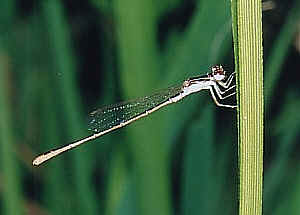
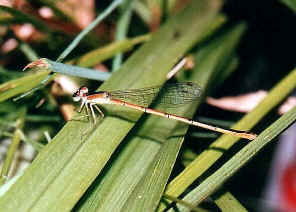
- Agriocnemis rubescens, Subfamily Agriocnemidinae (Midgets), male, female, body length 25mm
- This is a very tiny damselfly. It is pale black in colour with some pale red under the abdomen. We sometimes find them hiding within the plants along Bulimba Creek. They don't mind if my camera comes very close. More information please click here.
- Midget Whisp
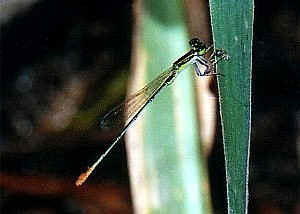
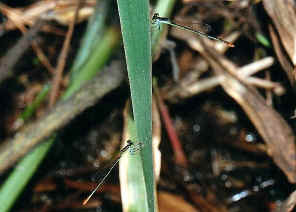
- Agriocnemis pygmaea, Subfamily Agriocnemidinae (Midgets), male, body length 20mm
- The Midget Whisp is the smallest damselflies we found. The head and thorax is pale green in colour with black pattern. Abdomen is pale red with black with the red tail light. More information on Midget Whisp page.
- Redrump Whisp Damselfly
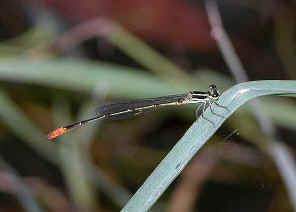
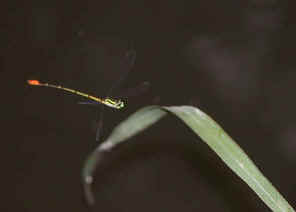
- Agriocnemis rubricauda, subfamily Agriocnemidinae (Midgets), male, body length 30mm
- The damselfly has the very bright orange-red tail. Its body is pale green and black in colour. We only saw this damselfly once along Bulimba Creek in Yugarapul Park. We took the photos late in the evening, while the sunlight was about to ease. The damselfly's tail of bright orange spot was outstanding from the dark surroundings. More pictures and information please visit this page.
- Eastern Dart Damselfly
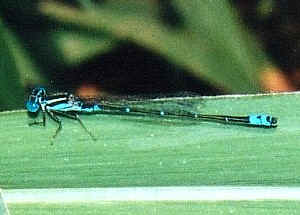
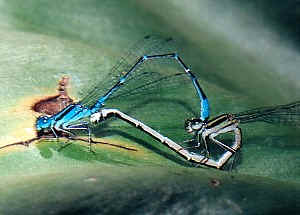
- Austroagrion watsoni , Subfamily Coenagrioninae, male, male and female, body length 25mm
- Eastern Dart Damselflies are tiny damselflies. They can be found near running water or still water. They usually rest on the plants either in the middle of ponds or at the water edges. The pictures in this page are mostly taken at Wishart along Bulimba Creek and at the large ponds in Mt Coot-tha Botanic Garden. More information please click here.
- Aurora Bluetail Damselflies
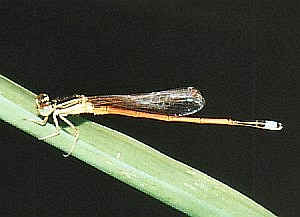
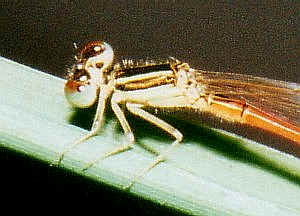
- Ischnura aurora, male, Subfamily Ischnurinae, body length 23mm
- Aurora Bluetail Damselflies are the very tiny damselflies. However, the males are beautifully have the colour of the rainbow. The head and thorax are from green to yellow, the abdomen is from yellow to orange to red. There is the bright blue at the tip. The back of the thorax is black. The females are pale grey in colour. Click here for more information.
- Common Bluetail Damselfly
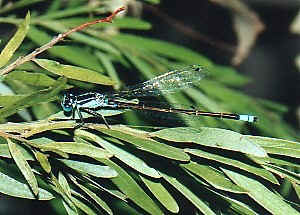
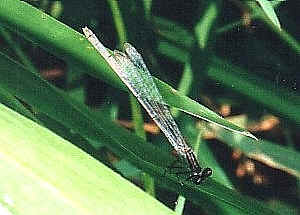
- Ischnura heterosticia, Subfamily Ischnurinae, male, female, body length 34mm
- Common Bluetail Damselflies are one of the most common damselflies found in Brisbane waters. They can easily be found near running water or still water, however, they are easily mistaken as Blue Sprite . Common Bluetail Damselflies are smaller, with more black than blue on their back. There is the blue tip at the end of abdomen. They usually rest on the plants either in the middle of ponds or at the water edges. The pictures taken at Wishart along Bulimba Creek. More information please click here.
- Big Red Damselfly
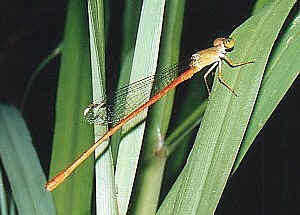
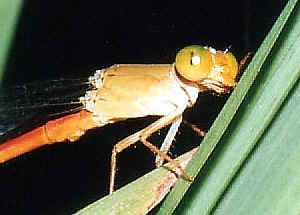
- Ceriagrion aeruginosum, Subfamily Pseudagrioninae, body length 40mm
- The Big Red Damselflies are beautiful with orange red abdomen, yellow green thorax and yellow green head. Although they are sharp in colour, they are not easily be seen. They usually hiding among the thick grass near the waters. We sometimes find them along Moolabin Creek in Brisbane. More information please click here.
- Blue Sprite Damselfly
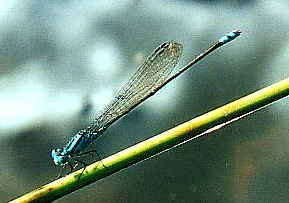
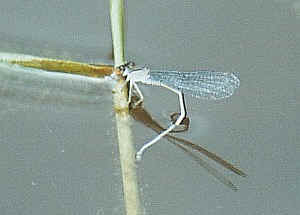
- Pseudagrion microcephalum, Subfamily Pseudagrioninae, male, female, body length 38mm
- The male damselfly is brightly blue in colour with black pattern on abdomen. Notice its blue head, its face and eyes are blue too. The female damselfly has the blue abdomen and yellowish-green thorax and eyes. We took those pictures at Wishart along Bulimba Creek. For more detail see our Blue Sprite Damselfly page.
- Gold Face Sprite Damselfly
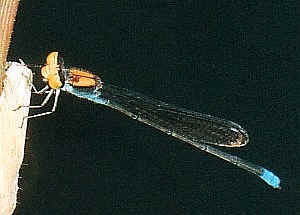
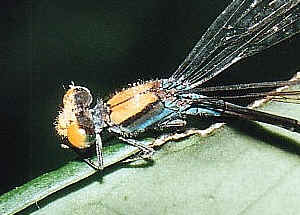
- Pseudagrion aureofrons, Subfamily Pseudagrioninae, male, body length 36mm
- Gold Face Sprite Damselflies can be found on running water or still water. They can be easily recognized by their golden-yellow faces. Their lower part of thorax are blue, with black colour in between. Their abdomen are black, with blue marking at tail. More information please click here.
- Flamehead Sprite Damsefly

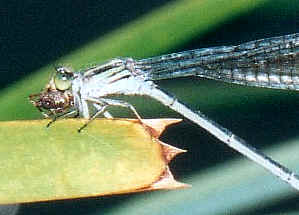
- Pseudagrion ignifer, Subfamily Pseudagrioninae, male, female, body length 46mm
- This is a large Damselfly. The second picture shows the female Blue Flamehead Damselfly she is enjoying a meal. More information please click here.
- Red and Blue Damselflies
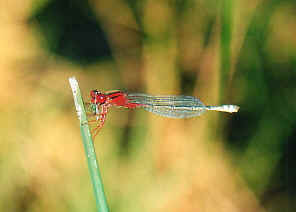
- Xanthagrion erythroneurum, Subfamily Pseudagrioninae, body length 40mm
- The Red and Blue Damselflies are with bright red face and thorax. Their abdomen is pale colour, with blue marking at tail. Red and Blue Damselfly larvae live in still water. We found the Red and Blue Damselflies along the water edge near the lake inside Minnippi Park, Tingalpa, where is the end of Bulimba Creek, about to meet the Brisbane River.
Family COENAGRIONIDAE - Pond Damselflies
Coenagrionidae is the most abundant damselfly in Brisbane area. They are usually with black pattern, the ground colour may be green, blue, yellow, orange, or purple. Some species are two female colour forms, one of which is similar to the male. Their wings are narrow, usually colourless and clear.
They prefer to lay eggs in pond or slow running water. They rest with the body horizontal and the wings pressed together above the abdomen.
For this family, we found quite a number of different species in Brisbane. Usually they are small and slender. The smallest damselflies are also found in this family.
